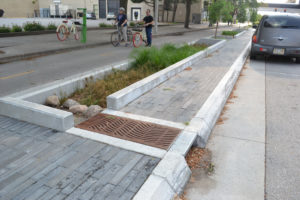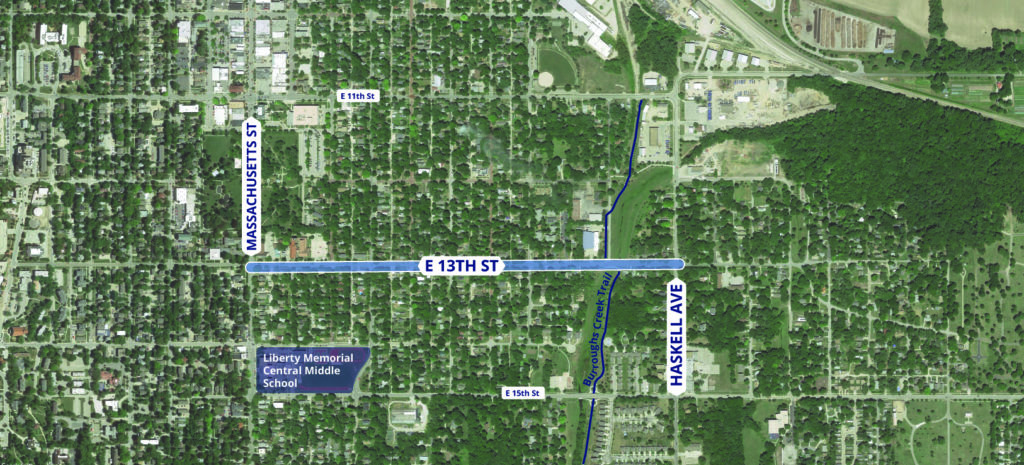Bicycle Boulevards Final Conceptual Design
We appreciate the feedback provided by everyone who took the survey on Lawrence Listens and/or attended one of our open houses. The final conceptual design of the 13th Street and 21st Street Bicycle Boulevards can be viewed at the links below. These designs will be presented to the Transportation Commission on Monday, June 3, and to the City Commission following that.
- 13th Street Final Conceptual Design (PDF): A presentation that outlines the proposed changes to 13th Street broken down by each affected intersection and roadway. Explanations of recommendations are included in the document.
- 21st Street Final Conceptual Design (PDF): A presentation that outlines the proposed changes to 21st Street broken down by each affected intersection and roadway. Explanations of recommendations are included in the document.
About the Project
The City of Lawrence is working to increase safe and comfortable bicycling for people living, working, and visiting our City. To meet this goal, the City will be developing plans for two bicycle boulevards in Lawrence: one on E 13th St., and one on W 21st St. The extents of each street being re-designed are shown below. These bicycle boulevards will be the first of their kind in Lawrence and are an important step in expanding the network of safe and comfortable streets for biking in the community.
E 13th St Corridor – Massachusetts St to Haskell Ave
W 21st St Corridor – Iowa St to Massachusetts St
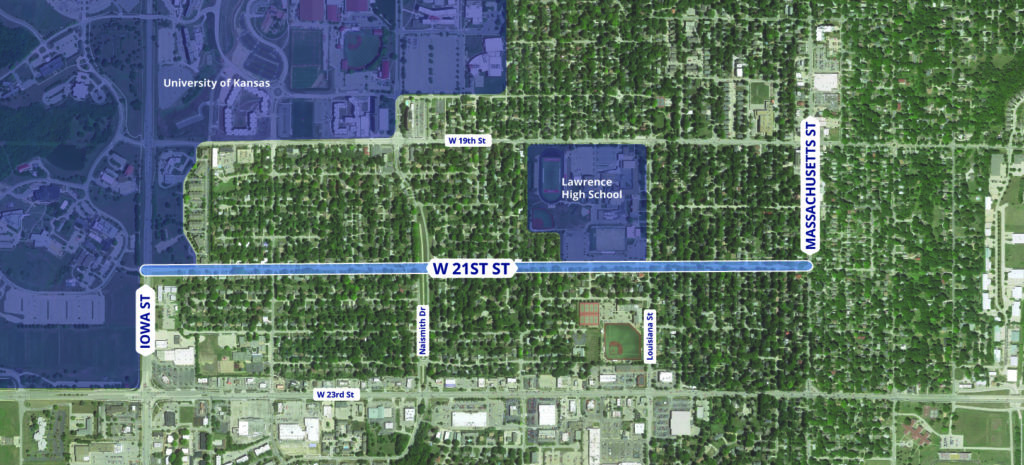
What are Bicycle Boulevards?
Bicycle Boulevards are streets with low motorized traffic volumes and speeds, designated and designed to offer low-stress bicycle travel for all ages, safe crossings for pedestrians, placemaking opportunities, as well as allow for motor vehicle travel at low speeds. Bicycle boulevards use signs, pavement markings, and speed and volume management measures to discourage pass-through motor vehicle trips and create safe, convenient bicycle crossings of busier streets.
Possible Bicycle Boulevard Design Features
There are many ways a bicycle boulevard could be designed in order to make bicycling more comfortable and convenient, while still allowing motor vehicles access at lower speeds. These design features can also make for a more pleasant walk! Click on each of the links below to learn about features that might be found on Lawrence bicycle boulevards.
- Route Planning: Direct access to destinations
- Signs: Easy to find and follow
- Pavement Markings: Increased visibility
- Speed Management: Reduced motor vehicle speeds
- Volume Management: Lower motor vehicle volumes
- Minor Street Crossings: Minimal bicyclist delay
- Major Street Crossings: Safe and convenient crossings
- Green Infrastructure: This optional element addresses water quantity and quality along a corridor. [1]
Route Planning
Route selection for bicycle boulevards is critical. Bicycle boulevards will not work if they are routed in illogical ways, if they require frequent or unnecessary stopping, or if they follow higher traffic speed and volume roadways. Bicycle boulevards have the potential to play a key role in low-stress bikeway network, as they can complement and provide strategic connections between, off-street paths, cycle tracks, and bike lanes. A bicycle boulevard should be considered where local streets offer a continuous and direct route along low-traffic streets.
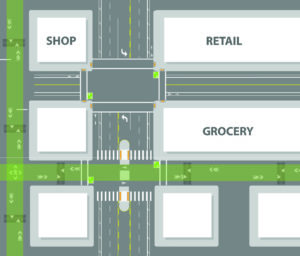
Wayfinding
As a basic, integral element of a bicycle boulevards, signs provide valuable wayfinding guidance and reinforce the intention of priority for bicyclists along a given route. Signs can take the shape of modified street signs that contribute to the identity of the roadway as a bicycle boulevard, and wayfinding signs that direct people bicycling (and walking) to nearby destinations along the route.
View Wayfinding Images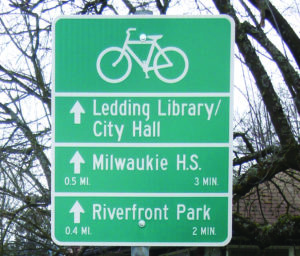
Pavement Markings
Like signs, pavement markings are also an essential element of a bicycle boulevard. Pavement markings indicate to motorists that a roadway is intended as a shared space for people driving and bicycling. They also support proper lane positioning for people bicycling, which can reduce improper passing and door zone conflicts.
View Pavement Marking Images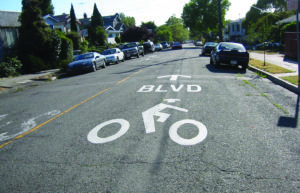
Speed Management
Speed management measures for bicycle boulevards bring motor vehicle speeds closer to those of bicyclists. Reducing speeds along bicycle boulevards improves the bicycling environment by reducing overtaking events, enhancing drivers’ ability to see and react, and diminishing the severity of crashes if they occur. Speed management is critical to creating a comfortable and effective bicycle boulevard. Streets developed as bicycle boulevards should have posted speed limits at 25 miles per hour or less.
View Speed Management Images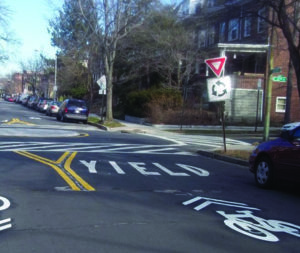
Volume Management
Volume management measures reduce or discourage through traffic on designated bicycle boulevards by physically or operationally reconfiguring select corridors and intersections along a route. On roadways with share travel lanes such as bicycle boulevards, motor vehicle traffic volumes significantly impact bicyclist comfort. Higher vehicle volumes decrease comfort and may lead to greater potential for conflicts, as well as loss of perceived safety.
View Volume Management Images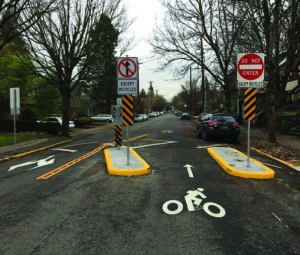
Minor Street Crossings
Minor street crossings for bicycle boulevards typically involve the intersection of two residential or local streets with low motor vehicle volumes and speeds. At intersections with local streets and minor collectors, bicycle boulevards should have the right-of-way priority and reduce or minimize delay by limiting the number of stop signs along the route. Stretches of at least half a mile or more of continuous travel without stop sign control are desirable.
View Minor Street Crossing Images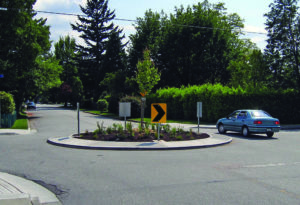
Major Street Crossings
Major street crossings may pose a significant barrier to the effectiveness and quality of a bicycle boulevard. Treatments of high quality should be selected to mitigate these barriers. Otherwise, it is recommended that another route or crossing that permits a higher level treatment should be selected. Selection of a given treatment depends upon several factors, including roadway width, speed, visibility, and the number and regularity of gaps.
View Major Street Crossing Images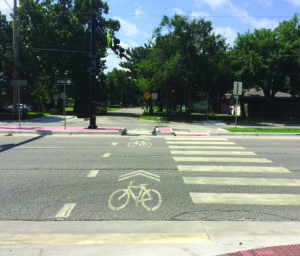
Green Infrastructure
Green infrastructure is a planning and design approach to managing stormwater, the urban heat island effect, and air quality based on ecosystem network models. A green infrastructure approach is a shift from viewing systems as separate and disjointed components toward viewing systems as interconnected amenities that improve public health. Bicycle boulevards present an opportunity to integrate stormwater treatment facilities, street trees, and public gathering spaces with traffic speed and volume management treatments.
View Green Infrastructure Images